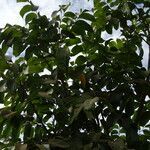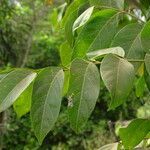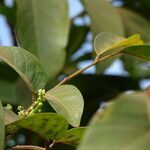A large spreading tree. It grows 10-14 m tall. It can be 35 m tall. The trunk is short and can be 2 m across. It has buttresses. The trunk is irregular and twisted with branches near the base. The bark is smooth and thin when young. It becomes yellow-grey and rough when old. It flakes off in large pieces. The leaves have an odd number of leaflets along the stalk. The stalk can be 30 cm long. There are 2-8 pairs of leaflets plus one extra. Each leaflet is stalked. The leaflets are rather stiff and oval. They are 5-20 cm long. The base of the leaflets is unequal. The tip is pointed. The leaflets are darker above than below. The flowers are in loose heads. These are 10-32 cm long. They occur beside the leaves. The flower stalks are dull red brown. The flowers are very small and white. The fruit is a soft fruit with a kernel in a stone. The flesh is edible. The fruit are blue-black and 2.5 cm across. The stone is four sided and contains seeds.
Leaves 5–17-foliolate; petiole and rhachis 10–50 cm. long, striate, glabrous, rarely pubescent; petiole dorsally convex, flat above; rhachis subcylindric; leaflets opposite or alternate, discolorous, sometimes shining, 5–20 × 3–8 cm., oblong-ovate to elliptic, the basal ones smaller, acuminate, the acumen obtuse, the terminal one symmetrically cuneate at the base, the others very asymmetric, entire, papyraceous to coriaceous, glabrous or rarely with the midrib pubescent below; petiolules 0·3–1 cm. long, grooved, glabrous or pubescent; midrib prominent mainly beneath, lateral nerves and venation scarcely raised on the upper surface, slightly prominent below.
A tall shrub with the main stems stout and spreading, or more often a tree up to 35 m. high; bole usually short, 3–18 m. tall and up to 2 m. in diam., twisted, strongly buttressed; bark greyish-yellow, falling off in large flakes.
Drupe blue-black when ripe, 1·5–2·5 × 1–1·8 cm., broadly ellipsoid when fresh; stone oblong-ovoid to obovoid, 4(5)-gonal, 4(5)-locular (usually only 1 loculus fertile), with 4(5) opercules near the apex.
Male flowers: sepals 4(5), 0·8–1 mm. long, ovate, obtuse, glabrous; petals whitish, 1·5–2·2 × 1–1·25 mm., elliptic; stamens 8(10), with very short filaments and 0·3–0·5 mm. long anthers.
Panicles up to as long as the leaves or longer, with the axis and branches dull-brownish-red, puberulous.
Female flowers: ovary globose, 4(5)-locular; styles 4.
Seed 10–15 × 2–4 mm., oblong.



